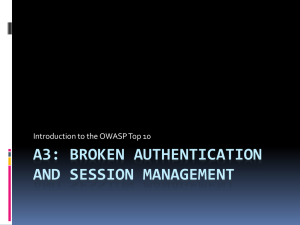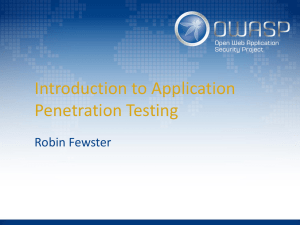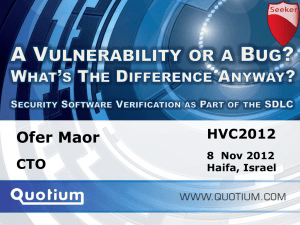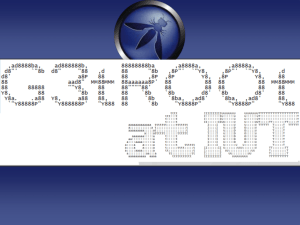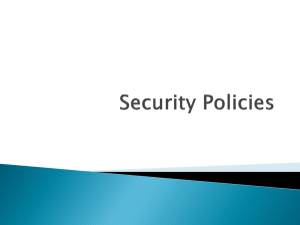Business Logic Attacks - Bots and BATs
advertisement
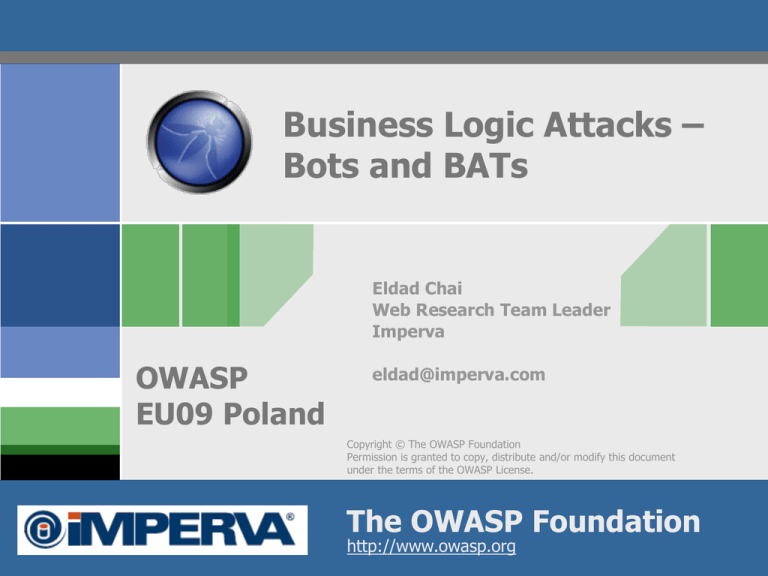
Business Logic Attacks – Bots and BATs Eldad Chai Web Research Team Leader Imperva OWASP EU09 Poland eldad@imperva.com Copyright © The OWASP Foundation Permission is granted to copy, distribute and/or modify this document under the terms of the OWASP License. The OWASP Foundation http://www.owasp.org Agenda Business Logic Attacks (BATs) – The Whats and Whys Classes of BATs BATs and Bots Mitigating BATs Summary Q&A OWASP AppSecEU09 Poland 2 Business Logic Attacks (BATs) – The Whats and Whys OWASP AppSecEU09 Poland 3 Business Logic Attacks (BATs) – The Whats and Whys What a BAT is / is not? Is not Is Malformed requests Legitimate requests Illegal input values Legitimate input values Usually a single request Usually multiple requests Changing a module’s functionality to inflict damage Abusing a module’s functionality to inflict damage Direct damage to the application Direct damage to the business Indirect damage to the business Indirect damage to the application OWASP AppSecEU09 Poland 4 Business Logic Attacks (BATs) – The Whats and Whys Why BATs? Technical types of attacks are gaining more awareness Better coding practices and tools at the development phase In some cases an entire class of vulnerabilities was eliminated out of the box Better assessment tools for detecting vulnerabilities Better tools for detecting and blocking attacks OWASP AppSecEU09 Poland 5 Business Logic Attacks (BATs) – The Whats and Whys So… why BATs? Require less understanding of the underlying technology More targets / opportunities out there Larger gain Can be “amplified” through automation OWASP AppSecEU09 Poland 6 Business Logic Attacks (BATs) – The Whats and Whys What damage can BATs do? Financial damage Damage to reputation DoS, EDoS/FDoS QoS degradation Data leakage OWASP AppSecEU09 Poland 7 Classes of BATs Classifying flaws Numerous examples of business logic flaws Both the business logic and its implementation might have flaws Classifying attacks The attack techniques are not so diverse Mainly because automation is usually required Automation techniques have much in common OWASP AppSecEU09 Poland 8 Abuse of Functionality – Brute Force Multiple invocations of transactions with random or semi-random data Usually includes repeating a request to a certain module with the intention of guessing valid values OWASP AppSecEU09 Poland 9 Abuse of Functionality – Brute Force Solution requirements Detection Identify failed transactions Measure the rate of failed transactions in real time Define acceptable thresholds for the rate of failed transactions in varying contexts: IP, session, user, systemwide, etc. Mitigation Anti-automation – Validate human interaction – Forced delays Reduce the effective rate of attacks to the point that they become futile OWASP AppSecEU09 Poland 10 Abuse of Functionality – Repetition Attacks Multiple invocations of requests with valid data Include repeating requests to a certain module with the intention of invoking a large number of business transactions OWASP AppSecEU09 Poland 11 Abuse of Functionality – Repetition Attacks Solution requirements Detection Identify successful transactions Measure the rate of successful transactions in real time Define acceptable thresholds for the rate of successful transactions in varying contexts: IP, session, user, systemwide, etc. Mitigation Anti-automation – Validate human interaction – Forced delays Reduce the effective rate of attacks to the point that they become futile OWASP AppSecEU09 Poland 12 Abuse of Functionality – Locking Business Resources OWASP AppSecEU09 Poland 13 Abuse of Functionality – Locking Business Resources Lock resources by doing nothing Invoke business transactions that (temporarily) consume / hold business resources Prevent the transactions from completing Resources are kept locked and pending, virtually unavailable to others OWASP AppSecEU09 Poland 14 Abuse of Functionality – Locking Business Resources Solution requirements Detection Identify unresolved transactions / incomplete business flows Define acceptable thresholds for holding transactions in an undecided state, before they become “stale” Measure the quantity of “stale” transactions Define acceptable thresholds for the number of “stale” transactions in varying contexts Mitigation Enforcing number and time length restrictions Gracefully rollback “stale” transactions / business flows OWASP AppSecEU09 Poland 15 Application Flow Bypass Bypass or circumvent the intended flow of an application This includes invoking transactions out of their intended order OWASP AppSecEU09 Poland 16 Application Flow Bypass Solution requirements Detection Identify a set of transactions that form a logical flow Define an acceptable order of transactions in a flow Mitigation Gracefully rollback transactions / business flows that do not comply with the flow definition OWASP AppSecEU09 Poland 17 Access Control Bypass Gaining access to parts of the application that otherwise would require increased access control Classic M&M security model Hard from the outside Soft from the inside OWASP AppSecEU09 Poland 18 Access Control Bypass Solution requirements Detection Identify application users and their roles Associate roles with privileged transactions Identify access to privileged transactions by an unprivileged user Mitigation Deny access from unprivileged users OWASP AppSecEU09 Poland 19 Web Leeching Leeching on business resources Contact forms (email spam) Sharing interfaces (comment spam) Redirect modules (phishing scams) Hotlinking (bandwidth leeching) Resource scraping (business data leeching) OWASP AppSecEU09 Poland 20 Web Leeching Solution requirements Detection Identify textual abuse patterns (e.g., comment spam, email spam) Identify abusive sources (e.g., by Referer, by IP) Identify intensive automated access Mitigation Block abusive access Anti-automation Throttle down automated access OWASP AppSecEU09 Poland 21 BATs and Bots Automation’s part of total attacks is growing Spam bots Email harvesters RFI bots SQLi bots … Automation is getting more sophisticated Deployment techniques Attack automation techniques OWASP AppSecEU09 Poland 22 BATs and Bots Online business transactions usually have a small effect on the business An attacker needs to invoke multiple transactions in order to have a significant effect Some examples of automated BATs: Brute force Repetition attacks DoS (EDoS/FDoS) Comment spam … OWASP AppSecEU09 Poland 23 Mitigating BATs First thing’s first: How do you know that you are susceptible to BATs? Use OWASP testing guide for business logic testing Use assessment services Purely automated scans usually don’t detect business logic flaws Cannot differentiate between a positive and a negative business effect Have a major disadvantage in assessing production environments OWASP AppSecEU09 Poland 24 Mitigating BATs Validate human interaction CAPTCHA Generic Affects user experience Blocks legitimate bots Second level authentication Authentication based on personal data Validates specific user Requires additional data Integrated Requires prior knowledge of all validation points Hard to validate based on user behavior External Can be generic Might require changing application responses Easy to validate suspicious sessions only OWASP AppSecEU09 Poland 25 Mitigating BATs Rolling back transactions Integrated Requires handling within several application modules Requires prior knowledge and definition of the protected flows and rollback sequences Implementation complexity is highly dependant on application architecture External Can be generic Easily integrated into existing detection and mitigation framework Might require additional session data Needs to be carefully designed and implemented OWASP AppSecEU09 Poland 26 Mitigating BATs Real time measurements Integrated Requires prior knowledge of what is to be measured Added complexity to the application Might be more accurate when conditions cannot be detected by external tools External Generic Easily integrated into existing detection and mitigation framework Not everything can be measured externally OWASP AppSecEU09 Poland 27 Mitigating BATs Force delays Integrated Require handling within several application modules In case of an attack, the application might be overhelmed Not really a “classic” internal feature External Can be generic Easily integrated into existing detection and mitigation framework Might be too crude OWASP AppSecEU09 Poland 28 Mitigating BATs Implement the solution requirements Pre-emptive approach (integrated) Implement solution requirements into the application code For all existing applications and all new applications Implementation can be tricky (measuring in real time, delays, abusive patterns, …) User experience is globally affected Alternative approach (external) Use a Web Application Firewall Change user experience only for suspicious sessions Coordinated security across domains Introduce fixes for crucial vulnerabilities with releases OWASP AppSecEU09 Poland 29 WAF Detection Requirements - BATs Identify business transactions Define failure / success conditions for a request (user/WAF) Identify transaction flows Define the set of transactions (user) and their order (user/WAF) Identify legitimate usage Define thresholds for flows: number, time length (user/WAF) Measure number, time length and rate in real time (WAF) Multiple contexts: IP, session, user, system-wide (WAF) Identify access control policy Define roles and associate users with roles (user) Identify application users’ transactions and compare against roles (WAF) OWASP AppSecEU09 Poland 30 WAF Detection Requirements - Bots Identify abuse patterns (WAF) Signatures for textual patterns Black lists for known malicious sources Profile for unknown malicious sources Identify intensive automated access (WAF) Malicious crawling patterns Non-browser access Automation patterns OWASP AppSecEU09 Poland 31 WAF Mitigation Requirements Block abuse access (easy…) Deny access from unprivileged users (easy…) Throttle down automated access (anti automation) Human interaction validation (e.g., CAPTCHA) Re-authentication Delays Enforce business flows Define rollback transactions for flows Rollback transactions / business flows based on a pre-defined rollback sequence OWASP AppSecEU09 Poland 32 Summary The risk of business logic attacks is increasing Business logic attacks abuse the web application’s functionalities Most classes of attacks require automation Detecting and mitigating BATs requires a new set of tools These tools can be implemented internally or externally WAFs can detect and mitigate BATs and Bots OWASP AppSecEU09 Poland 33 Thanks! Q&A OWASP AppSecEU09 Poland 34

